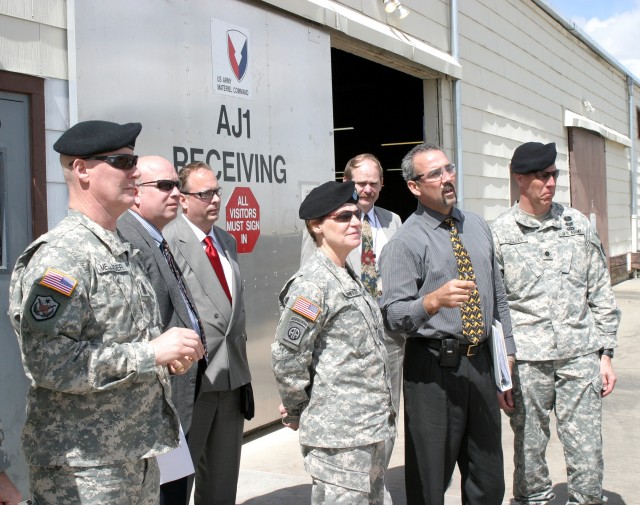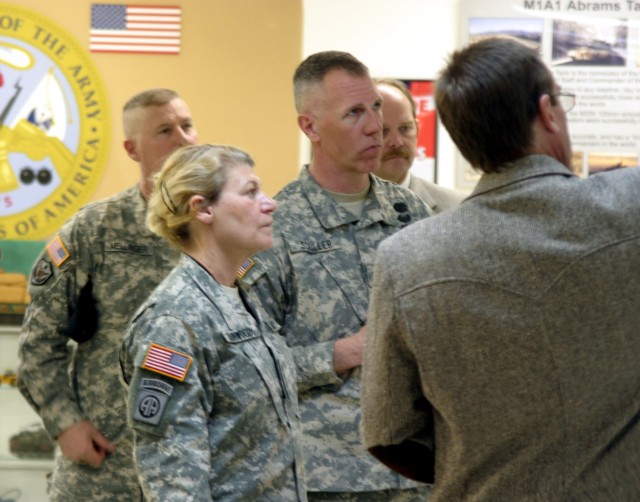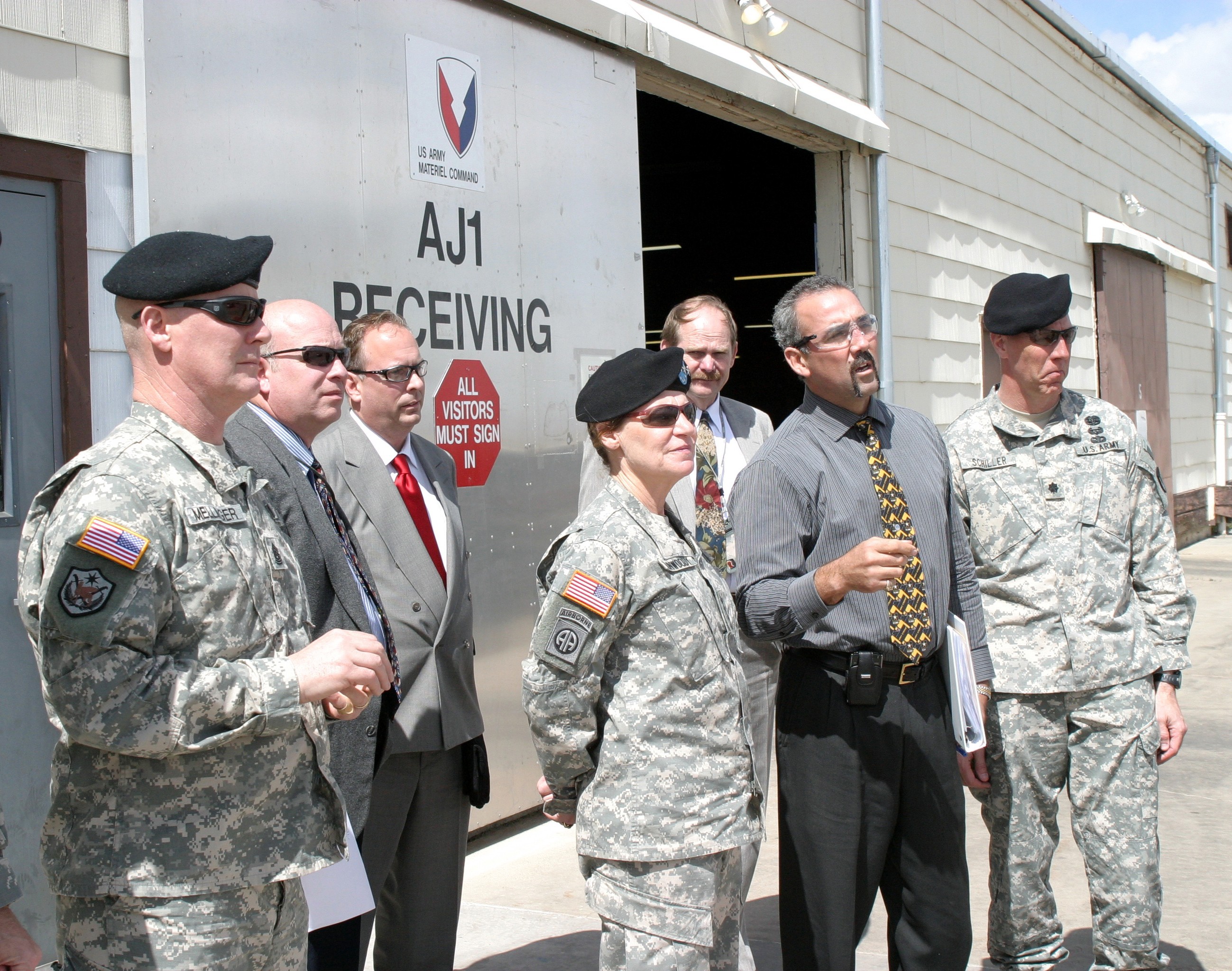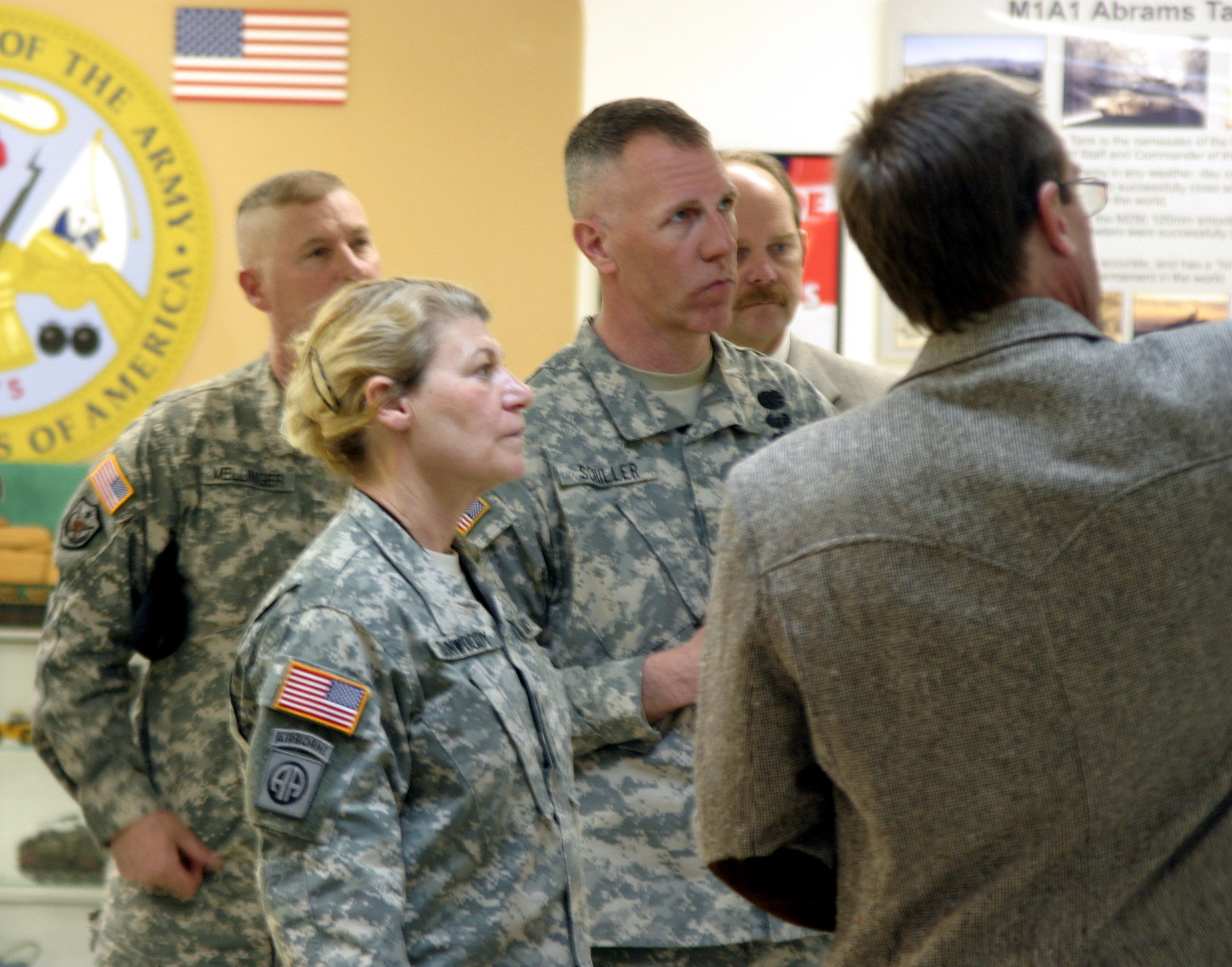Sierra Army Depot had the opportunity to show off their unique capabilities April 2 to the Department of the Army's highest ranking female officer.
Lt. Col. Lee H. Schiller, Jr., SIAD commander, and Donald Olson, SIAD deputy commander, greeted Gen. Ann E. Dunwoody, commanding general, U.S. Army Materiel Command, after her plane landed at Sierra's Amedee Army Airfield. From the moment Dunwoody's boots hit the ground the visit was in a fast pace motion to cover as much ground as possible in a short amount of time.
Her visit began with a trip to Sierra's newly-established "End of First Life Center", to view the thousands of combat tracked vehicles currently on site. Michael Winters, LTS supervisor, briefed Dunwoody on the processes used within the area and also talked about how he and his crew have embraced Continuous Process Improvements and the Lean Process throughout his area of responsibility. Winters gave a break-out of the makeup of the 7,000 plus combat vehicles: over 4,500 were from the M113 family, 1,850 tanks (includes 1,530 M1A1), and 121 Bradleys.
Dunwoody was impressed with the sheer volume and diversity of the vehicle fleet, the availability of room to grow in support of Army needs, and the readiness successes realized with a relatively small investment. She commented that the time was right for Sierra to provide increased support to the item managers (the vehicle owners); but that it was apparent there was a significant void in overarching long-term Enterprise fleet strategy for final disposition of these platforms.
Olson explained whether harvested and scrapped, or preserved and stored with a deliberate intent to refurbish for resale, the Material Enterprise must collectively decide how to capitalize on the value of this stagnant stock.
Schiller commented the depot has already realized substantial cost avoidance by staging this equipment at Sierra instead of a Defense Logistics Agency facility ($22 million in DLA storage fees avoided), and the time is ripe to further capitalize on these successes by formalizing and expanding the effort (like the Air Force did with their Aerospace Maintenance and Regeneration Group operation at Davis-Monthan AFB in AZ).
Designated by the SECDEF in 1964, Davis-Monthan Air Force Base serves as the consolidation point for the storage, disposal and reclamation of aircraft and aircraft components. Olson told Dunwoody he believe the Air Force model should be adapted to ground equipment at SIAD - to fill a critical void for the Army now and into the foreseeable future.
Olson further explained a critical component to this mission includes harvesting usable parts from these stagnant vehicles. The process currently starts when Item Managers direct Sierra to inventory the individual components in each end item (288 separate components inventoried in each M1 series tank), and provide that data electronically back to them for visibility of the status of their fleet.
The item managers then direct Sierra to remove a select group/number of those components and ship to a repair facility. In the past 5 years, more than $64 million in harvested parts were shipped to meet urgent demands at the supporting maintenance activity. The vehicles are then placed back into long term storage for further disposition.
Olson told Dunwoody this initiative needs to be managed through an automated process (visible across the Enterprise), with a clear requirements-based methodology - to optimize and exploit this substantive capability (the cost avoidance will grow dramatically). Sierra is currently bringing the parts to record in SDS Ammo (which provides item managers visibility) and is also the system item managers use to direct movement through an MRO.
Before leaving the vehicle parts reclamation area, Dunwoody heard that planning efforts to map processes and align requirements with the core competencies resident at Sierra will enable AMC to fully exploit the depot capabilities.
After leaving the LTS area, the group traveled to the Skedaddle Inn for a working lunch where Schiller showed Dunwoody the depot video followed by a command overview briefing. Schiller stated with over 30,000 buildable acres for open storage or expansion, 41 warehouses and magazines, almost 800 earth covered igloos, an experienced workforce that has embraced Continuous Process Improvement using Lean techniques - Sierra is uniquely postured to surge their operation along existing core capabilities to support the imminent drawdown effort from SWA.
During the briefing, Dunwoody learned firsthand of Sierra' strategic location, excellent transportation network, remote-location (no encroachment), excellent climate for storage, and capable workforce is ready to support the war fighter. She stated these functions should be further developed and considered core mission responsibilities at Sierra.
Dunwoody received information on the overarching concept that Sierra has developed and briefed over the past two years, to designate Sierra as the Army's End of First Life Center, and serve as the Army's Center of Excellence for excess Material or Equipment Redistribution. Additionally, Schiller talked about a few critical growth areas Sierra has the capability and capacity of handing that the Army should consider placing here.
Schiller began by talking about the number of containers that are currently in SWA and where will they be positioned when the drawdown begins. He said that container management and certification is definitely within Sierra's core competencies. Sierra has the capability to receive, secure, maintain, certify, store and ultimately ship "an unlimited" number of containers for the enterprise.
Some facilitization would be required to add additional hardstand space, and depending on the size of the mission, support for the consolidated container maintenance facility would be needed. However, the Depot's core capabilities in the area of material identification, classification, inventory management, weld repair, CSC certification, container modification, and shipment allow them to perform this function now.
Another area where the depot could grow is the receipt, identification, classification and processing to record all the non-specific equipment currently in use in theater. The depot would be able to provide visibility to some equipment manager, and store/ship based on direction received.
The next stop on the tour was the Southwest Asia Reverse Pipeline Excess Equipment Redistribution mission area. John Dingman, AJ1 director, began the tour by informing Dunwoody that Sierra currently operates the Army's largest SARRS SSA operation focused solely on the receipt, processing and redistribution of previously issued stock back into the supply system.
Since the depot started receiving excess material from Qatar, to today's operation that receives excess material from all classes of supply from posts, camps, and stations across the world - Sierra has continuously mapped, refined and Leaned their processes.
Dingman stated the depot has fully developed their processes to unpack containers, identify and classify the material, bring to an accountable record, perform inventory management functions, maintain visibility for the owner, and ultimately ship to an end user. He went on to say the depot also has the capacity to flex operations to meet emerging demands. Dingman further highlighted the depot's ability to receive containers from SWA in support of the imminent drawdown of our forces in theater.
Dingman walked with Dunwoody to the final stage of the tour where he highlighted the Depot's recent designation as the consolidation and distribution center for the Clothing Management Office. Under this program, Sierra receives/identifies/classifies and brings to record new Organizational Clothing & Individual Equipment directly from DLA, "excess" OCIE from Clothing and Issue Facilities, as well as returned items from SWA and posts/camps/stations - and subsequently ships reset "kits" to CIF's worldwide based on CMO direction.
Since the program started in June 2008, SIAD has shipped more than 450,000 pieces of clothing, body armor and heraldry items to 27 separate CIF's around the world - supporting critical reset activities for more than 60,000 Soldiers, with a cost savings to the Army Working Capital Fund of more than $24 million.
Dunwoody concluded her trip to Sierra by telling Schiller he has a great work force and should be extremely proud of the outstanding work and dedication displayed by his employees during her visit.




Social Sharing